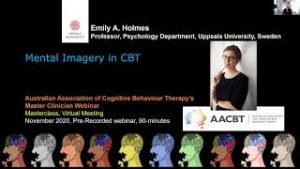Sorry, this product is no longer available for viewing
Master Clinician webinar series
Professor Emily Holmes (Uppsala University)

This approx. 1hr 40 min Master Clinician webinar was recorded in October 2020 and released in November 2020.

AACBT members can view for free.
Non-members may purchase here.
Using mental imagery is complementary to almost any therapeutic approach/age/diagnosis and may open up extra tools.
This masterclass will discuss the science and practice of imagery-based cognitive therapy, as well as new techniques developed in reference to our team’s work in trauma, depression, and bipolar disorder.
From a cognitive science perspective, mental imagery involves an experience like perception in the absence of a percept: seeing in our mind’s eye, for example. Imagery has extremely interesting properties – recruits similar brain areas to actual perception, enhances memory and learning and, compared to verbal processing, mental imagery has a more powerful impact on emotion.
From a clinical practice perspective, intrusive, affect-laden images cause distress across psychological disorders. Imagery-based intrusive memories and “flashbacks” to a past trauma are the hallmark of post-traumatic stress disorder (PTSD). Intrusive mental imagery can also occur of the future, such as ‘flashforwards‘ to suicidal acts or manic pursuits in bipolar disorder. We need to know how to work with dysfunctional imagery, and promote adaptive imagery using imagery-focused cognitive psychotherapy techniques.
Key Learning Objectives
- Explain and demystify mental images
- Understand how imagery has a powerful impact on emotion, motivation and behaviour
- Imagery “microformulation”, and how this leads to treatment selection
Emily will:
- Explain and demystify mental imagery
- Present what is mental imagery from clinical and theoretical perspectives
- Illustrate how to assess and ‘micro-formulate’ mental imagery across psychological disorders
- Briefly introduce a range of techniques for working clinically with mental images
- Use examples of how to apply these techniques in treating PTSD and bipolar disorder – other conditions will also be considered
Biographical Information
Emily Holmes, PhD, DClinPsych is a Professor in Psychology at the Department of Psychology, Uppsala University, Sweden. She is affiliated to the Karolinska Institutet’s Department of Clinical Neuroscience, and is a Visiting Professor of Clinical Psychology at the Department of Psychiatry, University of Oxford, UK.
Holmes received her degree in Experimental Psychology at the University of Oxford, UK. She is also a clinician and completed a clinical psychology training doctorate at Royal Holloway University of London, and a PhD in Cognitive Neuroscience in Cambridge, UK. She became Professor in 2010 at the University of Oxford. Holmes is an elected member of the Royal Swedish Academy of Sciences and is a Fellow of the British Academy of Social Sciences. She is the recipient of several international awards, including the American Psychological Association and the German Alexander von Humboldt Foundation. Holmes also serves on the Board of Trustees of the research charity “MQ; transforming mental health” and is an Associate Editor for Behaviour Research and Therapy.
Holmes’ work as a clinical psychologist has fuelled her research questions. She is interested in psychological treatment innovation in mental health – both in creating new techniques and reaching more people. Under the wider umbrella of mental health science, her approach brings together psychology, neuroscience, psychiatry, maths and more. Holmes’ research has demonstrated that mental imagery has a more powerful impact on emotion than its verbal counterpart. Her group is particularly interested in understanding and reducing intrusive memories after trauma. This is relevant for people after a traumatic event, whether a severe motor vehicle accident, traumatic childbirth, war or events during the COVID-19 pandemic.
Images supplied

